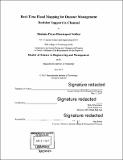| dc.contributor.advisor | Miho Mazereeuw. | en_US |
| dc.contributor.author | Dharmapuri Sridhar, Maanasa Priyaa | en_US |
| dc.contributor.other | System Design and Management Program. | en_US |
| dc.date.accessioned | 2018-02-08T16:27:15Z | |
| dc.date.available | 2018-02-08T16:27:15Z | |
| dc.date.copyright | 2017 | en_US |
| dc.date.issued | 2017 | en_US |
| dc.identifier.uri | http://hdl.handle.net/1721.1/113515 | |
| dc.description | Thesis: S.M. in Engineering and Management, Massachusetts Institute of Technology, System Design and Management Program, 2017. | en_US |
| dc.description | Cataloged from PDF version of thesis. | en_US |
| dc.description | Includes bibliographical references (pages 47-49). | en_US |
| dc.description.abstract | Crisis informatics: the multidisciplinary field combining computing and social science knowledge of disasters has become an important field of study in the last decade (Palen and Anderson 2016). With the unprecedented growth of social media, the disaster knowledge has transformed from being expert-driven knowledge to an everyday knowledge produced by different stakeholders (Hui and Tsang 2016). The aim of this research is to implement the concept of 'People as sensors' (Goodchild 2007) in India during disasters. People share granular geo-located information and broader dissemination of this Geo-social intelligence (Holderness 2014) outside of the traditional channels of emergency response. Chennai, the capital city of Tamil Nadu, is located in the southeastern India on the shores of the Bay of Bengal. With its low elevation coastal zone, inadequate provision for storm water runoff, and unregulated growth over wetlands (Parkash 2016), the city is prone to unpredictable rainfall and heavy flooding events during northeast monsoon season between October and December. The floods during December 2015 were one of the costliest natural disasters the city (T. E. Narasimhan, 2015) had witnessed and it exposed the critical need for providing real-time geospatial data to disaster managers to assist with their preparedness, rescue and relief operations. This project, initiated by Urban Risk Lab and supported by MIT Tata Center for Technology and Design (MIT Tata Center, 2016), involves developing RiskMap, a web-based platform to collect and validate real-time crowd-sourced flood reports via social media to enhance the city's resilience to extreme weather events. This thesis elaborates on the system design, development and analysis of the platform and provides suggestions for the future work. | en_US |
| dc.description.statementofresponsibility | by Maanasa Priyaa Dharmapuri Sridhar. | en_US |
| dc.format.extent | 49 pages | en_US |
| dc.language.iso | eng | en_US |
| dc.publisher | Massachusetts Institute of Technology | en_US |
| dc.rights | MIT theses are protected by copyright. They may be viewed, downloaded, or printed from this source but further reproduction or distribution in any format is prohibited without written permission. | en_US |
| dc.rights.uri | http://dspace.mit.edu/handle/1721.1/7582 | en_US |
| dc.subject | Engineering and Management Program. | en_US |
| dc.subject | Integrated Design and Management Program. | en_US |
| dc.subject | System Design and Management Program. | en_US |
| dc.title | Real-time flood mapping for disaster management decision support in Chennai | en_US |
| dc.type | Thesis | en_US |
| dc.description.degree | S.M. in Engineering and Management | en_US |
| dc.contributor.department | Massachusetts Institute of Technology. Engineering and Management Program | en_US |
| dc.contributor.department | System Design and Management Program. | en_US |
| dc.contributor.department | Massachusetts Institute of Technology. Integrated Design and Management Program | en_US |
| dc.identifier.oclc | 1020073569 | en_US |
